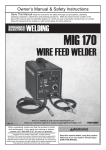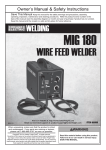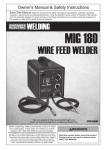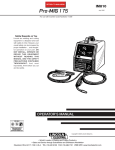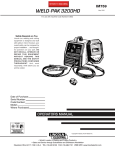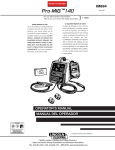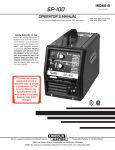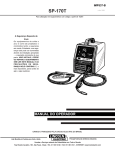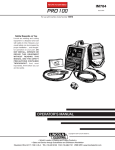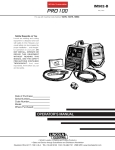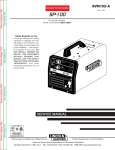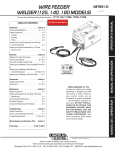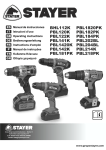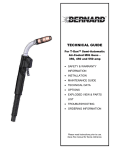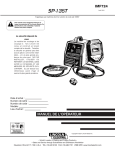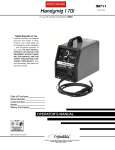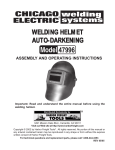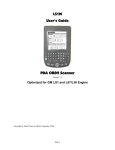Download Lincoln Electric IM795 User's Manual
Transcript
RETURN TO MAIN MENU IM795 SP 170-I March, 2004 For use with machine Code Numbers : 10982; 10983 Safety Depends on You Lincoln arc welding and cutting equipment is designed and built with safety in mind. However, your overall safety can be increased by proper installation ... and thoughtful operation on your part. DO NOT INSTALL, OPERATE OR REPAIR THIS EQUIPMENT WITHOUT READING THIS MANUAL AND THE SAFETY PRECAUTIONS CONTAINED THROUGHOUT. And, most importantly, think before you act and be careful. OPERATOR’S MANUAL Copyright © 2004 Lincoln Global Inc. • World's Leader in Welding and Cutting Products • • Sales and Service through Subsidiaries and Distributors Worldwide • Cleveland, Ohio 44117-1199 U.S.A. TEL: 216.481.8100 FAX: 216.486.1751 WEB SITE: www.lincolnelectric.com i i SAFETY WARNING CALIFORNIA PROPOSITION 65 WARNINGS Diesel engine exhaust and some of its constituents are known to the State of California to cause cancer, birth defects, and other reproductive harm. The Above For Diesel Engines The engine exhaust from this product contains chemicals known to the State of California to cause cancer, birth defects, or other reproductive harm. The Above For Gasoline Engines ARC WELDING CAN BE HAZARDOUS. PROTECT YOURSELF AND OTHERS FROM POSSIBLE SERIOUS INJURY OR DEATH. KEEP CHILDREN AWAY. PACEMAKER WEARERS SHOULD CONSULT WITH THEIR DOCTOR BEFORE OPERATING. Read and understand the following safety highlights. For additional safety information, it is strongly recommended that you purchase a copy of “Safety in Welding & Cutting - ANSI Standard Z49.1” from the American Welding Society, P.O. Box 351040, Miami, Florida 33135 or CSA Standard W117.2-1974. A Free copy of “Arc Welding Safety” booklet E205 is available from the Lincoln Electric Company, 22801 St. Clair Avenue, Cleveland, Ohio 44117-1199. BE SURE THAT ALL INSTALLATION, OPERATION, MAINTENANCE AND REPAIR PROCEDURES ARE PERFORMED ONLY BY QUALIFIED INDIVIDUALS. FOR ENGINE powered equipment. 1.h. To avoid scalding, do not remove the radiator pressure cap when the engine is hot. 1.a. Turn the engine off before troubleshooting and maintenance work unless the maintenance work requires it to be running. ____________________________________________________ 1.b. Operate engines in open, well-ventilated areas or vent the engine exhaust fumes outdoors. ____________________________________________________ 1.c. Do not add the fuel near an open flame welding arc or when the engine is running. Stop the engine and allow it to cool before refueling to prevent spilled fuel from vaporizing on contact with hot engine parts and igniting. Do not spill fuel when filling tank. If fuel is spilled, wipe it up and do not start engine until fumes have been eliminated. ____________________________________________________ 1.d. Keep all equipment safety guards, covers and devices in position and in good repair.Keep hands, hair, clothing and tools away from V-belts, gears, fans and all other moving parts when starting, operating or repairing equipment. ____________________________________________________ 1.e. In some cases it may be necessary to remove safety guards to perform required maintenance. Remove guards only when necessary and replace them when the maintenance requiring their removal is complete. Always use the greatest care when working near moving parts. ___________________________________________________ 1.f. Do not put your hands near the engine fan. Do not attempt to override the governor or idler by pushing on the throttle control rods while the engine is running. ELECTRIC AND MAGNETIC FIELDS may be dangerous 2.a. Electric current flowing through any conductor causes localized Electric and Magnetic Fields (EMF). Welding current creates EMF fields around welding cables and welding machines 2.b. EMF fields may interfere with some pacemakers, and welders having a pacemaker should consult their physician before welding. 2.c. Exposure to EMF fields in welding may have other health effects which are now not known. 2.d. All welders should use the following procedures in order to minimize exposure to EMF fields from the welding circuit: 2.d.1. Route the electrode and work cables together - Secure them with tape when possible. 2.d.2. Never coil the electrode lead around your body. 2.d.3. Do not place your body between the electrode and work cables. If the electrode cable is on your right side, the work cable should also be on your right side. 2.d.4. Connect the work cable to the workpiece as close as possible to the area being welded. ___________________________________________________ 1.g. To prevent accidentally starting gasoline engines while turning the engine or welding generator during maintenance work, disconnect the spark plug wires, distributor cap or magneto wire as appropriate. 2.d.5. Do not work next to welding power source. Mar ‘95 ii ii SAFETY ARC RAYS can burn. ELECTRIC SHOCK can kill. 3.a. The electrode and work (or ground) circuits are electrically “hot” when the welder is on. Do not touch these “hot” parts with your bare skin or wet clothing. Wear dry, hole-free gloves to insulate hands. 3.b. Insulate yourself from work and ground using dry insulation. Make certain the insulation is large enough to cover your full area of physical contact with work and ground. In addition to the normal safety precautions, if welding must be performed under electrically hazardous conditions (in damp locations or while wearing wet clothing; on metal structures such as floors, gratings or scaffolds; when in cramped positions such as sitting, kneeling or lying, if there is a high risk of unavoidable or accidental contact with the workpiece or ground) use the following equipment: • Semiautomatic DC Constant Voltage (Wire) Welder. • DC Manual (Stick) Welder. • AC Welder with Reduced Voltage Control. 3.c. In semiautomatic or automatic wire welding, the electrode, electrode reel, welding head, nozzle or semiautomatic welding gun are also electrically “hot”. 3.d. Always be sure the work cable makes a good electrical connection with the metal being welded. The connection should be as close as possible to the area being welded. 3.e. Ground the work or metal to be welded to a good electrical (earth) ground. 3.f. Maintain the electrode holder, work clamp, welding cable and welding machine in good, safe operating condition. Replace damaged insulation. 3.g. Never dip the electrode in water for cooling. 3.h. Never simultaneously touch electrically “hot” parts of electrode holders connected to two welders because voltage between the two can be the total of the open circuit voltage of both welders. 3.i. When working above floor level, use a safety belt to protect yourself from a fall should you get a shock. 3.j. Also see Items 6.c. and 8. 4.a. Use a shield with the proper filter and cover plates to protect your eyes from sparks and the rays of the arc when welding or observing open arc welding. Headshield and filter lens should conform to ANSI Z87. I standards. 4.b. Use suitable clothing made from durable flame-resistant material to protect your skin and that of your helpers from the arc rays. 4.c. Protect other nearby personnel with suitable, non-flammable screening and/or warn them not to watch the arc nor expose themselves to the arc rays or to hot spatter or metal. FUMES AND GASES can be dangerous. 5.a. Welding may produce fumes and gases hazardous to health. Avoid breathing these fumes and gases.When welding, keep your head out of the fume. Use enough ventilation and/or exhaust at the arc to keep fumes and gases away from the breathing zone. When welding with electrodes which require special ventilation such as stainless or hard facing (see instructions on container or MSDS) or on lead or cadmium plated steel and other metals or coatings which produce highly toxic fumes, keep exposure as low as possible and below Threshold Limit Values (TLV) using local exhaust or mechanical ventilation. In confined spaces or in some circumstances, outdoors, a respirator may be required. Additional precautions are also required when welding on galvanized steel. 5.b. Do not weld in locations near chlorinated hydrocarbon vapors coming from degreasing, cleaning or spraying operations. The heat and rays of the arc can react with solvent vapors to form phosgene, a highly toxic gas, and other irritating products. 5.c. Shielding gases used for arc welding can displace air and cause injury or death. Always use enough ventilation, especially in confined areas, to insure breathing air is safe. 5.d. Read and understand the manufacturer’s instructions for this equipment and the consumables to be used, including the material safety data sheet (MSDS) and follow your employer’s safety practices. MSDS forms are available from your welding distributor or from the manufacturer. 5.e. Also see item 1.b. Mar ‘95 iii iii SAFETY CYLINDER may explode if damaged. WELDING SPARKS can cause fire or explosion. 6.a. Remove fire hazards from the welding area. If this is not possible, cover them to prevent the welding sparks from starting a fire. Remember that welding sparks and hot materials from welding can easily go through small cracks and openings to adjacent areas. Avoid welding near hydraulic lines. Have a fire extinguisher readily available. 6.b. Where compressed gases are to be used at the job site, special precautions should be used to prevent hazardous situations. Refer to “Safety in Welding and Cutting” (ANSI Standard Z49.1) and the operating information for the equipment being used. 6.c. When not welding, make certain no part of the electrode circuit is touching the work or ground. Accidental contact can cause overheating and create a fire hazard. 6.d. Do not heat, cut or weld tanks, drums or containers until the proper steps have been taken to insure that such procedures will not cause flammable or toxic vapors from substances inside. They can cause an explosion even though they have been “cleaned”. For information, purchase “Recommended Safe Practices for the Preparation for Welding and Cutting of Containers and Piping That Have Held Hazardous Substances”, AWS F4.1 from the American Welding Society (see address above). 6.e. Vent hollow castings or containers before heating, cutting or welding. They may explode. 6.f. Sparks and spatter are thrown from the welding arc. Wear oil free protective garments such as leather gloves, heavy shirt, cuffless trousers, high shoes and a cap over your hair. Wear ear plugs when welding out of position or in confined places. Always wear safety glasses with side shields when in a welding area. 6.g. Connect the work cable to the work as close to the welding area as practical. Work cables connected to the building framework or other locations away from the welding area increase the possibility of the welding current passing through lifting chains, crane cables or other alternate circuits. This can create fire hazards or overheat lifting chains or cables until they fail. 6.h. Also see item 1.c. 7.a. Use only compressed gas cylinders containing the correct shielding gas for the process used and properly operating regulators designed for the gas and pressure used. All hoses, fittings, etc. should be suitable for the application and maintained in good condition. 7.b. Always keep cylinders in an upright position securely chained to an undercarriage or fixed support. 7.c. Cylinders should be located: • Away from areas where they may be struck or subjected to physical damage. • A safe distance from arc welding or cutting operations and any other source of heat, sparks, or flame. 7.d. Never allow the electrode, electrode holder or any other electrically “hot” parts to touch a cylinder. 7.e. Keep your head and face away from the cylinder valve outlet when opening the cylinder valve. 7.f. Valve protection caps should always be in place and hand tight except when the cylinder is in use or connected for use. 7.g. Read and follow the instructions on compressed gas cylinders, associated equipment, and CGA publication P-l, “Precautions for Safe Handling of Compressed Gases in Cylinders,” available from the Compressed Gas Association 1235 Jefferson Davis Highway, Arlington, VA 22202. FOR ELECTRICALLY powered equipment. 8.a. Turn off input power using the disconnect switch at the fuse box before working on the equipment. 8.b. Install equipment in accordance with the U.S. National Electrical Code, all local codes and the manufacturer’s recommendations. 8.c. Ground the equipment in accordance with the U.S. National Electrical Code and the manufacturer’s recommendations. Mar ‘95 iv iv SAFETY PRÉCAUTIONS DE SÛRETÉ Pour votre propre protection lire et observer toutes les instructions et les précautions de sûreté specifiques qui parraissent dans ce manuel aussi bien que les précautions de sûreté générales suivantes: Sûreté Pour Soudage A L’Arc 1. Protegez-vous contre la secousse électrique: a. Les circuits à l’électrode et à la piéce sont sous tension quand la machine à souder est en marche. Eviter toujours tout contact entre les parties sous tension et la peau nue ou les vétements mouillés. Porter des gants secs et sans trous pour isoler les mains. b. Faire trés attention de bien s’isoler de la masse quand on soude dans des endroits humides, ou sur un plancher metallique ou des grilles metalliques, principalement dans les positions assis ou couché pour lesquelles une grande partie du corps peut être en contact avec la masse. c. Maintenir le porte-électrode, la pince de masse, le câble de soudage et la machine à souder en bon et sûr état defonctionnement. d.Ne jamais plonger le porte-électrode dans l’eau pour le refroidir. e. Ne jamais toucher simultanément les parties sous tension des porte-électrodes connectés à deux machines à souder parce que la tension entre les deux pinces peut être le total de la tension à vide des deux machines. f. Si on utilise la machine à souder comme une source de courant pour soudage semi-automatique, ces precautions pour le porte-électrode s’applicuent aussi au pistolet de soudage. 2. Dans le cas de travail au dessus du niveau du sol, se protéger contre les chutes dans le cas ou on recoit un choc. Ne jamais enrouler le câble-électrode autour de n’importe quelle partie du corps. 3. Un coup d’arc peut être plus sévère qu’un coup de soliel, donc: a. Utiliser un bon masque avec un verre filtrant approprié ainsi qu’un verre blanc afin de se protéger les yeux du rayonnement de l’arc et des projections quand on soude ou quand on regarde l’arc. b. Porter des vêtements convenables afin de protéger la peau de soudeur et des aides contre le rayonnement de l‘arc. c. Protéger l’autre personnel travaillant à proximité au soudage à l’aide d’écrans appropriés et non-inflammables. 4. Des gouttes de laitier en fusion sont émises de l’arc de soudage. Se protéger avec des vêtements de protection libres de l’huile, tels que les gants en cuir, chemise épaisse, pantalons sans revers, et chaussures montantes. 5. Toujours porter des lunettes de sécurité dans la zone de soudage. Utiliser des lunettes avec écrans lateraux dans les zones où l’on pique le laitier. 6. Eloigner les matériaux inflammables ou les recouvrir afin de prévenir tout risque d’incendie dû aux étincelles. 7. Quand on ne soude pas, poser la pince à une endroit isolé de la masse. Un court-circuit accidental peut provoquer un échauffement et un risque d’incendie. 8. S’assurer que la masse est connectée le plus prés possible de la zone de travail qu’il est pratique de le faire. Si on place la masse sur la charpente de la construction ou d’autres endroits éloignés de la zone de travail, on augmente le risque de voir passer le courant de soudage par les chaines de levage, câbles de grue, ou autres circuits. Cela peut provoquer des risques d’incendie ou d’echauffement des chaines et des câbles jusqu’à ce qu’ils se rompent. 9. Assurer une ventilation suffisante dans la zone de soudage. Ceci est particuliérement important pour le soudage de tôles galvanisées plombées, ou cadmiées ou tout autre métal qui produit des fumeés toxiques. 10. Ne pas souder en présence de vapeurs de chlore provenant d’opérations de dégraissage, nettoyage ou pistolage. La chaleur ou les rayons de l’arc peuvent réagir avec les vapeurs du solvant pour produire du phosgéne (gas fortement toxique) ou autres produits irritants. 11. Pour obtenir de plus amples renseignements sur la sûreté, voir le code “Code for safety in welding and cutting” CSA Standard W 117.2-1974. PRÉCAUTIONS DE SÛRETÉ POUR LES MACHINES À SOUDER À TRANSFORMATEUR ET À REDRESSEUR 1. Relier à la terre le chassis du poste conformement au code de l’électricité et aux recommendations du fabricant. Le dispositif de montage ou la piece à souder doit être branché à une bonne mise à la terre. 2. Autant que possible, I’installation et l’entretien du poste seront effectués par un électricien qualifié. 3. Avant de faires des travaux à l’interieur de poste, la debrancher à l’interrupteur à la boite de fusibles. 4. Garder tous les couvercles et dispositifs de sûreté à leur place. Mar. ‘93 v SAFETY v vi SAFETY vi vii vii Thank You for selecting a QUALITY product by Lincoln Electric. We want you to take pride in operating this Lincoln Electric Company product ••• as much pride as we have in bringing this product to you! Please Examine Carton and Equipment For Damage Immediately When this equipment is shipped, title passes to the purchaser upon receipt by the carrier. Consequently, Claims for material damaged in shipment must be made by the purchaser against the transportation company at the time the shipment is received. Please record your equipment identification information below for future reference. This information can be found on your machine nameplate. Product _________________________________________________________________________________ Model Number ___________________________________________________________________________ Code Number or Date Code_________________________________________________________________ Serial Number____________________________________________________________________________ Date Purchased___________________________________________________________________________ Where Purchased_________________________________________________________________________ Whenever you request replacement parts or information on this equipment, always supply the information you have recorded above. The code number is especially important when identifying the correct replacement parts. On-Line Product Registration - Register your machine with Lincoln Electric either via fax or over the Internet. • For faxing: Complete the form on the back of the warranty statement included in the literature packet accompanying this machine and fax the form per the instructions printed on it. • For On-Line Registration: Go to our WEB SITE at www.lincolnelectric.com. Choose “Quick Links” and then “Product Registration”. Please complete the form and submit your registration. Read this Operators Manual completely before attempting to use this equipment. Save this manual and keep it handy for quick reference. Pay particular attention to the safety instructions we have provided for your protection. The level of seriousness to be applied to each is explained below: WARNING This statement appears where the information must be followed exactly to avoid serious personal injury or loss of life. CAUTION This statement appears where the information must be followed to avoid minor personal injury or damage to this equipment. viii viii TABLE OF CONTENTS Page Installation .......................................................................................................Section A Technical Specifications ........................................................................................A-1 Identify and Locate Components ...........................................................................A-2 Select Suitable Location ........................................................................................A-3 Output Connections ...............................................................................................A-3 Work Clamp Installation ..................................................................................A-3 Work Cable Installation ...................................................................................A-3 Gun Installation......................................................................................................A-4 Gas Connection .....................................................................................................A-4 Input Connections..................................................................................................A-5 Line Cord Connection ............................................................................................A-6 Operation .........................................................................................................Section B Safety Precautions ................................................................................................B-1 General Description ...............................................................................................B-2 Design Features and Advantages .........................................................................B-2 Welding Capability .................................................................................................B-2 Limitations..............................................................................................................B-2 Controls and Settings ............................................................................................B-2 Welding Operations ...............................................................................................B-3 Wire Loading ...................................................................................................B-3 Wire Threading................................................................................................B-4 Making a Weld ................................................................................................B-5 Process Guidelines................................................................................................B-5 Chaning Over to Feed Other Wire Sizes ...............................................................B-6 Welding with GMAW..............................................................................................B-6 Welding with FCAW...............................................................................................B-6 Overload Protection ...............................................................................................B-6 Application Chart ...................................................................................................B-7 Accessories .....................................................................................................Section C Accessories ...........................................................................................................C-1 Replacement Parts ................................................................................................C-2 Maintenance ....................................................................................................Section D Safety Precautions ................................................................................................D-1 Routine Maintenance.............................................................................................D-1 Gun and Cable Maintenance.................................................................................D-2 Configuration of Components in Wire Feeding System.........................................D-2 Component Replacement Procedures ..................................................................D-2 Troubleshooting ..............................................................................................Section E Safety Precautions.................................................................................................E-1 How to Use Troubleshooting Guide.......................................................................E-1 Troubleshooting Guide ..........................................................................................E-2 Wiring Diagrams ..............................................................................................Section F SP 170-I Wiring Diagram .......................................................................................F-1 SP 170-I Parts...............................................................................................P467 Series Wire Drive Assembly...........................................................................................P189-D A-1 A-1 INSTALLATION TECHNICAL SPECIFICATIONS – SP 170-I INPUT – SINGLE PHASE ONLY Standard Voltage/Frequency 230V/50/60Hz Input Current 20 Amps – Rated Output RATED OUTPUT Duty Cycle 25% 60% 100% Amps 125 85 70 Volts at Rated Amperes 20.25 18.25 17.50 OUTPUT Welding Current Range Rated DC Output: 30 – 175 amps Maximum Open Circuit Voltage 33 Wire Speed Range 50-400IPM (1.3-10.2m/min) RECOMMENDED INPUT CABLE AND FUSE SIZES Output Mode Input Voltage Fuse or Breaker Size Input Amps Power Cord RATED 230V/50/60Hz 30 Super Lag 20 16 Amp, 230V, Two-Prong International Cord Set (Supplied) PHYSICAL DIMENSIONS Height 12.0 in 305 mm Width 9.75 in 248 mm Depth 16.5 in 419 mm The SP170-I is designed for industrial and professional use in accordance with the standard EN 60974-1 / IEC 974-1. SP-170-I Weight 57 Ibs 25.9 kg A-2 A-2 INSTALLATION Read entire installation section before starting installation. 1 SAFETY PRECAUTIONS 2 E WARNING WELDI NG AM P RA NGE SP 1 70 -I ELECTRIC SHOCK can kill. • Only qualified personnel should perform this installation. • Only personnel that have read and understood the SP 170-I Operating Manual should install and operate this equipment. • Machine must be plugged into a receptacle which is grounded per any national, local or other applicable electrical codes. 4 • The SP 170-I power switch is to be in the OFF (“O”) position when installing work cable and gun and when connecting power cord to input power. 3 8 6 IDENTIFY AND LOCATE COMPONENTS 5 If you have not already done so, unpack the SP 170-I from its carton and remove all packing material around the SP 170-I. Remove the following loose items from the carton (see Figure A.1): 1. SP 170-I 2. Gun and cable assembly(1) 3. Literature and miscellaneous including: a) This operating manual b) Contact tips: SP 170-I 2 .025” (0.6mm) for solid wire 2 .030” (0.8mm) for solid wire 1 .035” (0.9mm) for cored wire c) 5/64” (2.0 mm) Hex key wrench for removal of drive roll. 4. 10 ft (3,0 m) work cable. 5. Work clamp. 6. 14.0 ft (4.3 m) .19” (4.8 mm) dia. gas hose 7. 2- Hose clamps 8. Gas nozzle (1) The gun is ready to feed .035" (0.9mm) diameter. SP 170-I 7 FIGURE A.1 A-3 A-3 INSTALLATION SELECT SUITABLE LOCATION 3. Connector Block. The SP 170-I has an IP21S rating. Locate the welder in a dry location where there is free circulation of clean air into the louvers in the back and out the front of the unit. A location that minimizes the amount of smoke and dirt drawn into the rear louvers reduces the chance of dirt accumulation that can block air passages and cause overheating. 4. Gun Trigger Lead Connectors. 5. Positive (+) and negative (–) output terminals. 6. Wire Feed Gearbox / Feedplate 7. Cable Hanger. 8. Thumbscrew. STACKING SP 170-I’s cannot be stacked. Refer to the Accessories Section for available optional TILTING equipment. Each machine must be placed on a secure, level surface, either directly or on the recommended cart. The machine may topple over if this procedure is not followed. Work Clamp Installation Attach the work clamp per the following: Refer to Figure A-3 FIGURE A.3 LIMITATIONS STRAIN RELIEF HOLE WORK CABLE The SP 170-I cannot be used for pipe thawing. NUT AND BOLT MIG welding and flux cored arc welding are the only processes supported by the SP 170-I WORK CLAMP The handle can not be used for transport by crane. OUTPUT CONNECTIONS 1. Insert the work cable terminal lug with the larger hole through the strain relief hole in the work clamp as shown above. Refer to Figure A.2. 1. Work Cable Access Hole. 2. Fasten securely with the bolt and nut provided. 2. Gun Cable and Control Lead Access Hole. 4 E 5 + SP 170 - I 1 8 2 - 3 FIGURE A.2 SP 170-I 6 7 A-4 A-4 INSTALLATION Work Cable Installation Connecting Gun Cable to the SP 170-I Refer to Figure A.2. As shipped the gun is fitted with a liner suitable for all wire diameters from .025” - .035” (0.6mm - .9mm) and has an .035” (0.9mm) contact tip installed. 1. Open the wire feed section door on the right side of the SP 170-I. 2. Pass the end of the work cable that has the terminal lug with the smaller hole through the Work Cable Access Hole (1) in the case front. 3. Route the cable under the feedplate (6) and in front of the Wire Feed Motor. 4. For Innershield Only: Refer to Figure A.2. As delivered, the machine is connected for negative electrode polarity. This is the appropriate configuration for the Innershield process. To complete installation, use the provided wing nut to connect the work cable’s terminal lug to the positive (+) output terminal (4) located above the Wire Feed Gearbox (5). Make sure that both wing nuts are tight. 5. For GMAW Only: Refer to Figure A.4. To wire for positive polarity (required for the GMAW process), connect the short cable attached to the connector block (1) to the positive (+) output terminal (4) and the work cable (3) to the negative (-) terminal (2). 1. Refer to Figures A.2 and A.4. Unplug the machine or turn power switch to the OFF “O” position. 2. Pass the insulated terminals of the gun trigger control leads, one at a time, through the Gun Cable and Control Lead Access Slot (A.2-2) in the case front. The leads are to be routed up the inside of the case front, behind the gas line. 3. Insert the connector on the gun conductor cable through the Gun Cable Access Hole (A.2-2) in the SP 170-I case front. Make sure the connector is all the way in the brass connector block to obtain proper gas flow. If the gun connector will not fully insert, unscrew the thumbscrew on the connector block a few turns. Rotate the connector so control leads are on the underside and tighten the Thumbscrew on the connector block. 4. Connect the gun trigger control lead terminals to the two insulated 1/4" (6,4 mm) tab terminal connector bushings located above the “Gun Trigger Connection” decal in the wire feed section (A.4). Either lead can go to either connector. CAUTION 4 If the gun trigger switch being used is other than that supplied, the switch must be a normally open, momentary switch. The terminals of the switch must be insulated from the welding circuit. Malfunction of the SP 170-I may result if this switch shorts to the SP 170-I welding output circuit or is common to any electrical circuit other than the SP 170-I trigger circuit. 3 2 1 5 GAS CONNECTION When using the MIG process, a cylinder of shielding gas must be obtained. See Table B.1. Additionally a flow regulator is required. For more information, refer to the ACCESSORIES section. FIGURE A.4 GUN INSTALLATION As shipped from the factory, the SP 170-I gun is ready to feed .035 Innershield. If other wire is to be used, change the contact tip to the appropriate size. SP 170-I A-5 A-5 INSTALLATION let and open the cylinder valve very slightly for an instant. This blows away any dust or dirt which may have accumulated in the valve outlet. WARNING CYLINDER may explode if damaged. Keep cylinder upright and chained to support WARNING • Keep cylinder away from areas where it may be damaged. BE SURE TO KEEP YOUR FACE AWAY FROM THE VALVE OUTLET WHEN “CRACKING” THE VALVE. Never stand directly in front of or behind the flow regulator when opening the cylinder valve. Always stand to one side. • Never lift welder with cylinder attached. • Never allow welding electrode to touch cylinder. • Keep cylinder away from welding or other live electrical circuits. 3. Attach the flow regulator to the cylinder valve and tighten the union nut securely with a wrench.. NOTE: If connecting to 100% CO2 cylinder, make certain the plastic washer is seated in the fitting that attaches to the CO2 cylinder. WARNING BUILDUP OF SHIELDING GAS may harm health or kill. • Shut off shielding gas supply when not in use. • SEE AMERICAN NATIONAL STANDARD Z-49.1, “SAFETY IN WELDING AND CUTTING” PUBLISHED BY THE AMERICAN WELDING SOCIETY. 4. Refer to Figure A.6. Attach one end of inlet gas hose to the outlet fitting of the flow regulator and tighten the gas line hose clamp. Connect the other end to the SP 170-I Gas Solenoid Inlet nipple. Make certain the gas hose is not kinked or twisted. Tighten the gas line hose clamp. INPUT CONNECTIONS Refer to Figure A.6. 1. Chain the cylinder to a wall or other stationary support to prevent the cylinder from falling over. Insulate the cylinder from the work circuit and earth ground. Refer to Figure A.5. Cylinder Valve Flow Regulator GAS SOLENOID INLET NIPPLE Gas Hose POWER INPUT CABLE FIGURE A.6 FIGURE A.5 2. With the cylinder securely installed, remove the cylinder cap. Stand to one side away from the outSP 170-I A-6 INSTALLATION Line Cord Connection A 3 conductor international cordset with a 16 amp, 230 volt, two-prong plug is factory installed. Connect this plug to a mating grounded receptacle which is connected to an appropriate power supply per any applicable local codes. Input Voltage Hertz Type 75°C Wire in Conduit, Copper Cond. AWG Size 230 50/60 8 Grounding Wire Copper Cond. AWG Size Fuse Size (Super Lag) 10 40 CONNECT TO A SYSTEM GROUNDING WIRE. SEE THE UNITED STATES NATIONAL ELECTRICAL CODE AND/OR LOCAL CODES FOR OTHER DETAILS AND MEANS FOR PROPER GROUNDING. CONNECT TO HOT WIRES OF A THREE-WIRE SINGLE PHASE SYSTEM OR TO ONE PHASE OF A TWO OR THREE PHASE SYSTEM. WARNING This welding machine must be connected to a power source in accordance with applicable electrical codes. The National Electrical Code provides standards for amperage handling capability of supply conductors based on duty cycle of the welding source. If there is any question about the installation meeting applicable electrical code requirements, consult a qualified electrician. SP 170-I A-6 B-1 OPERATION B-1 GENERAL DESCRIPTION Read entire operation section before operating the SP 170-I. The SP 170-I is a complete semiautomatic constant voltage DC portable arc welder. Included is a tapswitch controlled, single phase constant voltage transformer/rectifier power source and a wire feeder with welding gun for feeding .025" (0.6 mm) through .030" (0.8 mm) solid steel electrode and .035" (0.9 mm) Innershield® NR-211-MP. WARNING ELECTRIC SHOCK can kill. • Do not touch electrically live parts or electrode with skin or wet clothing. Insulate yourself from work and ground. It is ideally suited for individuals having access to 230V 50/60 Hz AC input power and want the ease of use, quality and dependability of both gas metal arc welding or GMAW (also known as MIG welding) and the Innershield® process (self-shielded flux-cored or FCAW). A convenient chart is mounted inside the wire feed section door for setting welding procedures for 24 gauge (.60 mm) through 5/16" (8.0 mm) mild steel. The machine is rugged and reliable and is designed for dependable service and long life. • Always wear dry insulating gloves. FUMES AND GASES can be dangerous. • Keep your head out of fumes. • Use ventilation or exhaust to remove fumes from breathing zone. RECOMMENDED PROCESSES The SP 170-I can be used for welding mild steel, stainless steels and aluminum using the GMAW, single pass, process (MIG) which requires a supply of shielding gas or it can be used for the self-shielded, Innershield® process (FCAW). WELDING SPARKS can cause fire or explosion. • Keep flammable material away. • Do not weld on closed containers. OPERATIONAL FEATURES AND CONTROLS The SP 170-I has the following controls as standard: Power ON/OFF Switch, Voltage Control, Wire Speed Control, Trigger Switch, and a Circuit Breaker. ARC RAYS can burn eyes and skin. DESIGN FEATURES AND ADVANTAGES • Wear eye, ear and body protection. ● “Cold electrode” until gun trigger is pressed for an added measure of safety. ● Overload protection — incorporates both a thermo- stat and a circuit breaker. Observe all safety information throughout this manual. ● Quality wire drive with electronic overload protec- tion. ● “Quick Release” idle roll pressure arm is easily adjusted. ● Reversible, dual groove drive roll, shipped ready to feed .030" (0.8 mm) diameter solid wire or .035" diameter flux-cored wire. The drive roll is easily reversed to feed .025" (0.6 mm) diameter solid wire. ● SP-170-I B-2 OPERATION B-2 ● No external shielding gas is required when used 6. Gun Trigger - Activates welding output, wire feed, with Lincoln Innershield .035” (0,9 mm) NR®-211MP electrode. and gas solenoid operation. Releasing the trigger deactivates welding and simultaneously activates the “burnback” function so that the welding wire does not stick in the weld puddle. ● Spindle accommodates both 8 in. (200 mm) diame- ter and 4 in. (100 mm) diameter spools of wire. FIGURE B.1a WELDING CAPABILITY The SP 170-I is rated at 125 amps, 20.25 volts, at 25% duty cycle on a ten minute basis. It is capable of higher output currents at lower duty cycles. Actual welding outputs will range between 30 and 175 amps for the recommended processes. 1 LIMITATIONS 2 3 4 E Arc Gouging cannot be performed with the SP 170-I. The SP 170-I is not recommended for pipe thawing or TIG welding. SP 170 - I CONTROLS AND SETTINGS Refer to Figures B.1a (Items 1 thru 4) 1. Power ON/OFF Switch — When the power is on the fan motor will run and air will be exhausted out the louvers in the front of the machine. The welding output and wire feeder remain off until the gun trigger is pressed. 2. Voltage Control — A 5-position tap selector switch gives full range adjustment of power source output voltage. Do not switch while welding. 3. Wire Speed Control — Controls the wire feed speed from 50 – 400 in/min (1.3 – 10.2 m/min). The control can be preset on the dial to the setting specified on the SP 170-I Application Chart located on the inside of the wire feed section door. FIGURE B.1b 5 ON OFF ARC VOLTS 6 WIRE SPEED 4. Temperature Light — Indicates thermostat has cut the output. The fan will be running. Thermostat resets automatically. (Refer to Figure B.1b, Items 5,6) 5. Circuit Breaker – Protects machine from damage if maximum output is exceeded. Button will extend out when tripped (Manual reset). SP 170-I B-3 B-3 OPERATION WELDING OPERATIONS SEQUENCE OF OPERATION Wire Loading Refer to Figures B.2 and B.3. 4" Wire Spool Wire Spindle Shaft The machine power switch should be turned to the OFF (“O”) position before working inside the wire feed enclosure. The welder is shipped from the factory ready to feed 8" (200 mm) diameter spools with 2.2" (56 mm) maximum width. These spools fit on a 2" (51 mm) diameter spindle that has a built in, adjustable friction brake to prevent overrun of the spool and excess slack in the wire. Note:When loading and removing the 8” Spools make sure that the wing nut (inside the wire spool spindle hub) is turned 90° from the wire spool spindle locking tab. If the wing nut is positioned in line with the locking tab, the tab cannot be depressed to load or unload the wire spool. FIGURE B.2 Wire Spool Spindle 8” Wire Spool Wing Nut and Spacer To Wire Drive FIGURE B.3 Friction Brake Adjustment With wire spool installed on the spindle shaft and the wing nut loose, turn the spool by hand while slowly tightening the wing nut until a light drag is felt. Tighten the wing nut an additional 1/4 turn. Note: When properly adjusted, the brake should provide only enough drag to prevent overrun of the spool and excess slack in the wire. Too much drag may result in wire feeding problems, and may cause premature wear of wire drive system components. Be sure that this stud engages the hole in the wire spool. To Wire Drive Wire Spool must be pushed all the way on the spindle so that the spindle’s tab will hold it in place. The Wire Spool will rotate clockwise when wire is dereeled. Load an 8” (200 mm) diameter spool on the wire spool spindle shown in Figure B.2. To use 4” (100 mm) diameter spools, the 2” (50 mm) diameter spindle must be removed (See Figure B.3). Remove the wing nut and spacer at the end of the shaft and remove the outside plastic wire spool spindle. The spindle can be stored in the wire feed compartment. A 4” (100 mm) diameter spool is mounted directly on the 5/8” (16 mm) diameter shaft and held in place with the previously removed hardware. Also make certain the start end of the wire, which may protrude through the side of the spool does not contact any metallic case parts. SP 170-I B-4 B-4 OPERATION Refer to Figure B.4 1. Release the Spring Loaded Pressure Arm (1) rotate the Idle Roll Arm (2) away from the Wire Feed Drive Roll (3). Ensure that the groove size in the feeding position on the drive roll matches the wire size being used. This occurs when the desired groove is located on the inside, toward the feedplate. See Maintenance section for further information. 2 1 4 5 3 2. Carefully detach the end of the wire from the spool. To prevent the spool from unwinding, maintain tension on the wire until after step 5. The Wire Drive Feed Roll can accommodate two wire sizes by flipping the wire drive feed roll over. 3. Cut the bent portion of wire off and straighten the first 4” (100 mm). FIGURE B.4 4. Thread the wire through the ingoing guide tube (4), over the drive roll (3), and into the outgoing guide tube (5). Check the alignment of the wire over the drive roll groove and adjust if necessary. If alignment adjustment is necessary use the allen wrench provided to loosen the drive roll, move it to the desired position and then retighten. Gun Handle Gas Diffuser 5. Close the idle roll arm (2) and latch the spring loaded pressure arm (1) in place. Rotate the spool counterclockwise if required to take up extra slack in the wire. Contact Tip Gas Nozzle 6. The idle roll pressure adjustment wing nut is factory set to approximately five full turns from where the wing nut first engages the threads of the pressure arm (1). If feeding problems occur because the wire is flattened excessively, turn the pressure adjustment counter-clockwise to reduce distortion of the wire. Slightly less pressure may be required when using 0.023 – 0.025" (0,6 mm) wire. If the drive roll slips while feeding wire, the pressure should be increased until the wire feeds properly. WARNING When inching the welding wire, the drive rolls, the gun connector block and the gun contact tip are electrically energized relative to work and ground and remain energized for several seconds after the gun trigger is released. FIGURE B.5 7. Refer to Figure B.5. Remove gas nozzle and contact tip from end of gun. 8. Turn the SP 170-I ON (“I”). 9. Straighten the gun cable assembly. 10. Depress the gun trigger switch and feed welding wire through the gun and cable. (Point gun away from yourself and others while feeding wire.) Release gun trigger after wire appears at end of gun. 11. Turn the SP 170-I OFF (“O”). 12. Replace contact tip and gas nozzle. 13. Refer to Figure B-6. Cut the wire off 3/8” – 1/2” (10 – 12 mm) from the end of the tip. The SP 170-I is now ready to weld. SP 170-I B-5 B-5 OPERATION Contact Tip SP-170 -I GUN CABLE Wire Electrode 3/8" – 1/2" (10 - 12 mm)Contact Tip To Work Distance(CTWD) WORKPIECE ARC FIGURE B.6 WORK CLAMP Making A Weld 1. See “Process Guidelines” in this section for selection of welding wire and shielding gas and for range of metal thicknesses that can be welded. 2. See the Application chart on the inside of the wire feed compartment door for information on setting the SP 170-I controls. Refer to Table B.1 for aluminum and stainless wire. 3. Set the Voltage (“V”) and Wire Speed (“olo’”) controls to the settings suggested for the welding wire and base metal thickness being used, refer to 3. Applications chart on the inside of the wire drive compartment door. 4. Check that the polarity is correct for the welding wire being used and that the gas supply, if required, is turned on. 5. When using Innershield electrode, remove the gas nozzle and install a gasless nozzle. This will improve visibility of the arc and protect the gas diffuser from weld spatter. Refer to the MAINTENANCE section for details on nozzle replacement. 6. Refer to Figure B.7. Connect work clamp to metal to be welded. Work clamp must make good electrical contact to the workpiece. The workpiece must also be grounded as stated in “Arc Welding Safety Precautions” in the beginning of this manual. 7. Position gun over joint. End of wire may be lightly touching the work. 8. Lower welding helmet, close gun trigger, and begin welding. Hold the gun so the contact tip to work distance is about 3/8 inch (10 mm). 9. To stop welding, release the gun trigger and then pull the gun away from the work after the arc goes out. FIGURE B.7 10. When no more welding is to be done, close valve on gas cylinder (if used), momentarily operate gun trigger to release gas pressure, and turn off the SP 170-I. Cleaning Tip And Nozzle Clean the contact tip and nozzle to avoid arc bridging between the nozzle and contact tip which can result in a shorted nozzle, poor welds and an overheated gun. Hint: Anti-stick spray or gel, available from a welding supply distributor, may reduce buildup and aid in spatter removal. PROCESS GUIDELINES The SP 170-I can be used for welding mild steel, stainless steel and aluminum using the MIG process and also for welding mild steel with the gasless selfshielded, Innershield® process (FCAW). The recommended gases and electrodes for MIG (GMAW) are welding grade CO2 gas or an argon-CO2 blended gas (75 to 80% argon and 25 to 20% CO2) and .025" (0.6 mm) and .030” (0.8mm) diameter Lincoln L-56 mild-steel welding wire, supplied on 121/2 lb (5.7 kg) spools. The blended gas is recommended for welding on heavier steel, 14 gauge (2.0 mm), for example. The recommended electrode for the self-shielded process is Lincoln Innershield® NR-211-MP on 10 lb (4.5 kg) spools. This electrode is available as .035" (0.9 mm) and .045" (1.2 mm) NR-211-MP for all position welding of 18 gauge (1.2 mm) through 5/16" (8.0 mm) steel. Thickness of 1/4" (6.4 mm) and 5/16" (7.9 mm) require multiple passes. both wire sizes can also be used for the welding of galvanized coated sheet metal. SP 170-I B-6 OPERATION The SP 170-I is suitable for .035" (0.9 mm) aluminum wire and .023"– .035" (0.6 - 0.9 mm) stainless wire. Refer to Table B.1 for Recommended Procedure Settings. Aluminum wire requires an Aluminum Welding kit. See ACCESSORIES section. 3. Keep the cylinder valve closed, except when using the SP 170-I. When finished welding: a) Close the cylinder valve to stop gas flow. b) Depress the gun trigger briefly to release the pressure in the gas hose. CAUTION c) Turn off the SP 170-I. It is important when changing between welding with steel wire and aluminum to exchange feeding components due to the lubricant applied to steel wire. Failure to do so may result in contaminated welds when welding aluminum. -----------------------------------------------------------------------TABLE B.1 — SP 170-I WELDING PROCEDURES Process Welding Wire Shielding Gas Voltage/Wire Speed 22 ga 16 ga 12 ga 1/8” 3/16” 1/4” .035 Dia(0.9mm 100% Argon B-5 B-7 E-9 G-9 I-9 4043 Aluminum Wire 16 ga 14 ga 12 ga 10 ga MIG DC+ .030 Dia 98% Argon/ A-3 C-6 308L Stainless 2% Oxygen Steel Wire B-6 J-10* WELDING WITH FCAW (Innershield) When using the FCAW process, the correct drive roll and electrode polarity must be used. See Work Cable Installation in INSTALLATION section for changing the polarity. Innershield welding kits K549-1 (for .035") and K549-2 (for .045") are also available. D-7.5 D-7.5 OVERLOAD PROTECTION CHANGING MACHINE OVER TO FEED OTHER WIRE SIZES The SP 170-I is shipped from the factory ready to feed 0.035" (0.9 mm) Innershield diameter wire. To operate the SP 170-I with other sizes of wire, it maybe necessary to change the contact tip and change the drive roll over to other sizes. Refer to Changing the Contact Tip and Changing the Drive Roll, in the MAINTENANCE section, for specific information on these procedures. WELDING WITH GMAW (MIG) Shielding Gas When using the GMAW process, obtain and install a gas regulator and hose kit. If using 100% CO2 a CO2 adapter is required, sold separately. Output Overload The SP 170-I is equipped with a circuit breaker which protects the machine from damage if a severe overload occurs. The circuit breaker button will extend out when tripped. The circuit breaker must be manually reset. Thermal Protection The SP 170-I has a rated output duty cycle of 20%. If the duty cycle is exceeded, a thermal protector will shut off the output until the machine cools to a reasonable operating temperature. This is an automatic function of the SP 170-I and does not require user intervention. The fan continues to run during cooling. Electronic Wire Drive Motor Protection The SP 170-I has built-in protection for wire drive motor overload. 1. For CO2, open the cylinder very slowly. For argonmixed gas, open cylinder valve slowly a fraction of a turn. When the cylinder pressure gauge pointer stops moving, open the valve fully. 2. If using a regulator with an adjustable flow meter, close the gun trigger and adjust the flow to give 15 – 20 cubic ft per hour (CFH) (7 – 10 I/min) [use 20 – 25 CFH (10 – 12 I/min) when welding out of position or in a drafty location. SP 170-I .045 in. (1.2 mm) DIA. INNERSHIELD NR®-211-MP .035 in. (0.9 mm) DIA. INNERSHIELD NR®-211-MP .030 in. (0.8 mm) DIA. SOLID STEEL WIRE .025 in. (0.6 mm) DIA. SOLID STEEL WIRE WELDING WIRE SP-170-I GASLESS FLUX-CORED DC(-) MIG DC(+) NONE NONE (7 5 -8 0 % A rg o n , 2 5 -2 0 % C O 2 ) C20 or C25 CO2 (7 5 -8 0 % A rg o n , 2 5 -2 0 % C O 2 ) C20 or C25 CO2 SHIELDING GAS OUTPUT POLARITY GASLESS FLUX-CORED DC(-) MIG DC(+) PROCESS B-1 A-1 C-3 C-3 B-4 C-3 .060 in. 1.6 mm B-1 B-2 D-5 D-4 C-5 D-5 .075 in. 2.0 mm STEEL THICKNESS C-1.5 B-2 E-8 E-6.5 D-6 E-7.5 .105 in. 2.5 mm C-1.5 C-2.5 E-8 .135 in. 3.5 mm DRIVE ROLL ORIENTATION A-1 A-1 B-3 C-3 B-2 B-3 B-3 C-3 .048 in. 1.2 mm A-2 B-2 .036 in. 1.0 mm D-2 D-2.5 3/16 in. 5.0 mm LARGE GROOVE SMALL GROOVE (BEVEL SIDE) EITHER GROOVE Optional knurled drive roll for .035 and .045 wire included in the .045 (1.2 mm) Innershield Kit. EITHER GROOVE .045 (1.2 mm) DIA. INNERSHIELD NR®-211-MP .035/.045 liner and appropriate tip must be installed in gun - see manual. LARGE GROOVE -- OR -- .035 (0.9 mm) DIA. INNERSHIELD NR®-211-MP GASLESS FLUX-CORED DC(-) APPLICATION CHART Be sure to read and understand the warnings on this welding machine and the section on ARC WELDING SAFETY PRECAUTIONS in the Operating Manual. Because design, fabrication, assembly and welding variables affect the results obtained in applying this type of information, the serviceability of a product or assembly is the responsibility of the builder/user. .030 (0.8 mm) DIA. SOLID STEEL WIRE .025 (0.6 mm) DIA. SOLID STEEL WIRE MIG DC(+) E-2.5* D-2.5* 5/16 8.0 mm * Multiple passes required E-2* D-2.5* 1/4 in. 6.0 mm ALIGN GROOVE WITH CENTER OF GUIDE TUBES, SECURE DRIVE ROLL WITH SET SCREW CENTERED ON FLAT A-2 B-2 B-2 A-2 .030 in. 0.80 mm .024 in. 0.60 mm ADJUST FOR OPTIMUM WELDING FOR STAINLESS STEEL AND ALUMINUM SETTINGS - SEE MANUAL SUGGESTED SETTINGS FOR WELDING B-7 B-7 L10732 SP170-I C-1 ACCESSORIES OPTIONAL ACCESSORIES See Maintenance section for instructions on installing drive roll, cable liner, contact tip and their proper configuration. 1. KP665-045C Drive Roll – Optional — Knurled drive roll for feeding .035 - .045” (0.9 - 1.2 mm) diameter flux-cored electrode. C-1 3. K464 .035" (0.9 mm) Innershield® Welding Kit — Includes a contact tip, a gasless nozzle and a .035/.045" (0.9/1.2 mm) cable liner to permit the gun and cable to use .035" (0.9 mm) diameter fluxcored electrode. The fitting on the end of the liner is stenciled with the maximum rated wire size (.045"/1.2 mm). Also included is a 10 lb.(4.5 kg.) spool of .035" (0.9 mm) Innershield® NR-211-MP. For use with “Lincoln Electric®” gun (with black trigger). The end of the brass fitting on the end of the .035/.045” (0.9/1.2mm) liner is color coded green. (The .023-.030” (0.6-0.8mm) liner is color coded orange). 2. K520 Utility Cart — Designed to transport the Lincoln family of small welders. Has provisions for mounting a single gas cylinder. Has front casters and large rear wheels. Handle height is easily adjustable. Bottom tray provided for tools and accessories. Easy assembly required; takes less than 15 minutes. See “Innershield (FCAW) Conversion” in this section for installation instructions and MAINTENANCE section for proper feeding component configuration and installation. 4. K491 .045" (1.2 mm) Innershield® Welding Kit — Includes a contact tip, a gasless nozzle and a .035/.045" (0.9/1.2 mm) cable liner to permit the gun and cable to use .045" (1.2 mm) diameter fluxcored electrode. The fitting on the end of the liner is stenciled with the maximum rated wire size (.045"/1.2 mm). Also included is a 10 lb.(4.5 kg.) spool of .045" (1.2 mm) Innershield® NR-211-MP and a knurled drive roll for .035” (0.9mm) and .045” (1.2mm) wire. For use with “Lincoln Electric®” gun (with black trigger). The end of the brass fitting on the end of the .035/.045” (0.9/1.2mm) liner is color coded green. (The .023-.030” (0.6-0.8mm) liner is color coded orange). See “Innershield (FCAW) Conversion” in this section for installation instructions and MAINTENANCE section for proper feeding component configuration and installation. SP-170-I C-2 ACCESSORIES MIG (GMAW) CONVERSION C-2 REPLACEMENT PARTS Several changes are needed to convert the unit for operation with the MIG (GMAW) process. The following conversions should be reviewed before welding with (GMAW): Complete Gun and Cable Assembly (Code 10983) L11951 Complete Gun and Cable Assembly (Code 10982) L8311-5 1. Change the output polarity to DC(+). See “Work Cable Installation” in Installation section for details. 2. Install proper drive roll for the wire size selected. See “Changing Drive Roll” in Maintenance section for details. 3. Install the proper gun liner and tip for the wire size selected. See “Component Replacement” in Maintenance section for details. 4. Remove gasless nozzle (if installed) and install gas nozzle. 5. Load wire into machine and thread into gun and cable per “Welding Wire Loading” section. SP 170-I D-1 MAINTENANCE MAINTENANCE SAFETY PRECAUTIONS WARNING ELECTRIC SHOCK can kill. • Disconnect input power by removing plug from receptacle before working inside SP170-I. Use only grounded receptacle. Do not touch electrically “hot” parts inside SP 170-I. • Have qualified personnel do the maintenance and trouble shooting work. ROUTINE MAINTENANCE POWER SOURCE COMPARTMENT In extremely dusty locations, dirt may clog the air passages causing the welder to run hot. Blow dirt out of the welder with low pressure air at regular intervals to eliminate excessive dirt and dust build-up on interval parts. WIRE FEED COMPARTMENT 1. When necessary, vacuum accumulated dirt from gearbox and wire feed section. 2. Occasionally inspect the incoming guide tube and clean inside diameter if necessary. 3. Motor and gearbox have lifetime lubrication and require no maintenance. FAN MOTOR Has lifetime lubrication — requires no maintenance. WIRE REEL SPINDLE Requires no maintenance. Do not lubricate shaft. SP 170-I D-1 D-2 D-2 MAINTENANCE GUN AND CABLE MAINTENANCE Gun Cable Cleaning Clean cable liner after using approximately 300 lbs (136 kg) of solid wire or 50 lbs (23 kg) of flux-cored wire. Remove the cable from the wire feeder and lay it out straight on the floor. Remove the contact tip from the gun. Using low pressure air, gently blow out the cable liner from the gas diffuser end. CAUTION Excessive pressure at the start may cause the dirt to form a plug. Flex the cable over its entire length and again blow out the cable. Repeat this procedure until no further dirt comes out. Contact Tips, Nozzles, and Gun Tubes 1. Dirt can accumulate in the contact tip hole and restrict wire feeding. After each spool of wire is used, remove the contact tip and clean it by pushing a short piece of wire through the tip repeatedly. Use the wire as a reamer to remove dirt that may be adhering to the wall of the hole through the tip. 2. Replace worn contact tips as required. A variable or “hunting” arc is a typical symptom of a worn contact tip. To install a new tip, choose the correct size contact tip for the electrode being used (wire size is stenciled on the side of the contact tip) and screw it snugly into the gas diffuser. 3. Remove spatter from inside of gas nozzle and from tip after each 10 minutes of arc time or as required. 4. Be sure the gas nozzle is fully screwed onto the diffuser for gas shielded processes. For the Innershield® process, the gasless nozzle should be screwed onto the diffuser. 5. To remove gun tube from gun, remove gas nozzle or gasless nozzle and remove diffuser from gun tube. Remove the four screws from the gun handle and separate the handle halves. (For L8311-5 gun and cable handle half says magnum 100L. Remove both collars from each end of the gun handle and separate the handle halves). Loosen the locking nut holding the gun tube in place against the gun end cable connector. Unscrew gun tube from cable connector. To install gun tube, screw the locking nut on the gun tube as far as possible. Then screw the gun tube into the cable connector until it bottoms. Then unscrew (no more than one turn) the gun tube until its axis is perpendicular to the flat sides of the cable connector and pointed in the direction of the trigger. Tighten the locking nut so as to maintain the proper relationship between the gun tube and the cable connector. Replace the gun handle, trigger and diffuser. Replace the gas nozzle or gasless nozzle. CONFIGURATION OF COMPONENTS IN WIRE FEEDING SYSTEM Components shipped with SP 170-I* Contact Tip Cable Liner Drive Roll .035” (0.9mm) .025”-.035” (0.6-.9mm) KP665-035 2 Smooth grooves Small .025” (0.6mm) Large .030” (0.8mm) * If other size wire feeding is desired use the additional Contact Tips shipped loose with your SP 170-I. • It is important when changing between welding with steel wire and aluminum to exchange feeding components due to the lubricant applied to steel wire. Failure to do so may result in contaminated welds when welding aluminum. SP-170-I D-3 D-3 MAINTENANCE COMPONENT REPLACEMENT PROCEDURES 7. Remove the drive roll, flip over and reinstall with the .023/.025" (0.6mm) groove (the smaller groove) closest to the gearbox. CHANGING THE CONTACT TIP (These instructions pertain to the Lincoln Electric® gun. The instructions for the Magnum™ 100L gun, are similar except that the gas nozzle is threaded.) 1. Refer to Figure D.2a or D.2b. Remove the gas nozzle from the gun by pulling and rotating it clockwise off the diffuser. (Threadless slip fit). 8. Push a length of straightened welding wire through the wire feeder guide tubes and adjust the position of the drive roll so that the groove is centered on the wire. Make certain the set screw is located on the flat portion of the shaft and tighten. FIGURE D.1 2. Remove the existing contact tip from the gun by gripping it with pliers and twisting counter-clockwise. Tip will now slip out of diffuser. 3. Insert new tip into diffuser. Grip it with pliers, push tip into diffuser until it bottoms, then twist clockwise to tighten. 3 4. Replace gas nozzle. 2 CHANGING DRIVE ROLL The drive roll has two grooves; one for .023" – .025" (0.6 mm) solid steel electrode and a larger groove for .030" (0.8 mm) solid and .035" (0.9 mm) flux-cored steel electrode. As shipped, the drive roll is installed in the .030"-.035" (0.8/0.9mm) position. If .023"/.025" (0.6mm) wire is to be used, the drive roll must be reversed as follows: 1. Connect the machine to its rated input power per instructions in Installation section. 2. Release the spring-loaded pressure arm and lift the idle roll arm away from the drive roll. 3. Turn the power switch to ON (marked “I”). 4. Set the wire speed to minimum and jog the drive unit with the trigger switch until the drive roll set screw is facing up. CAUTION When inching the welding wire, the drive rolls, gun connector block, and gun contact tip are energized relative to work and ground and remain energized for several seconds after the gun trigger is released. 5. Turn the power switch to OFF (marked “O”). 6. Loosen the drive roll set screw with the 5/64" (2.0 mm) hex wrench supplied. SP 170-I 1 D-4 MAINTENANCE D-4 CHANGING LINER NOTICE: The variation in cable lengths prevents the interchangeability of liners. Once a liner has been cut for a particular gun, it should not be installed in another gun unless it can meet the liner cutoff length requirement. Refer to Figure D.2a or D.2b. Gas Diffuser Contact Tip Allen Head Screw Brass Cable Connector 1. Remove the gas nozzle from the gun (threadless slip-fit or threaded). Gas Nozzle or Gasless Nozzle (Slip-Fit) 2. Remove the existing contact tip from the gun by twisting counter-clockwise. 3. If the gun is a Magnum 100L Fig D.2b. Remove the gas diffuser from the gun tube by unscrewing counter-clockwise. Liner Assembly (Liner bushing to be seated tight against brass cable connector) FIGURE D.2a Liner trim length for gun (Lincoln Electric®) 4. Lay the gun and cable out straight on a flat surface. Loosen the set screw located in the brass connector at the wire feeder end of the cable. Pull the liner out of the cable. 5. Insert a new untrimmed liner into the connector end of the cable. Be sure the liner bushing is stenciled appropriately for the wire size being used. 1-1/4 (31.8 mm) Liner Trim Length Gas Diffuser 7A. (For Gun Shown in Fig D.2a) With the torch extended straight out, cut the liner flush with the end of the diffuser. Rotate the gun clockwise until the liner protrudes out the end of the diffuser enough to cut off an additional 2 coils (approx. 2mm). Rotate the handle back to the original position. Contact Tip Allen Head Screw Brass Cable Connector 6. Fully seat the liner bushing into the connector. Tighten the set screw on the brass cable connector. Gas Nozzle or Gasless Nozzle (Threaded) Liner Assembly (Liner bushing to be seated tight against brass cable connector) FIGURE D.2b Liner trim length for gun (Magnum™ 100L) 7B. (For Gun Shown in Fig D.2b) With the gas nozzle and diffuser removed from the gun tube, be sure the cable is straight, and then trim the liner to the length shown in the Figure D.2b. Remove any burrs from the end of the liner. Screw the gas diffuser onto the end of the gun tube and securely tighten. 8. Replace the contact tip and nozzle. SP 170-I D-5 D-5 MAINTENANCE GUN HANDLE PARTS (Lincoln Electric) GUN HANDLE PARTS (Magnum 100L) The gun handle consists of two halves that are held together with four screws. To open up the gun handle assembly, remove the four screws and pry down the trigger handle half with a screwdriver. See Figure D.3. FIGURE D.3 The gun handle consists of two halves that are held together with a collar on each end. To open up the handle, turn the collars approximately 60 degrees counter-clockwise until the collar reaches a stop. Then pull the collar off the gun handle. If the collars are difficult to turn, position the gun handle against a corner, place a screwdriver against the tab on the collar and give the screwdriver a sharp blow to turn the collar past an internal locking rib. See Figure D-4. Screwdriver ➣ Counter-clockwise Cable FIGURE D.4 SP 170-I E-1 TROUBLESHOOTING E-1 HOW TO USE TROUBLESHOOTING GUIDE WARNING Service and Repair should only be performed by Lincoln Electric Factory Trained Personnel. Unauthorized repairs performed on this equipment may result in danger to the technician and machine operator and will invalidate your factory warranty. For your safety and to avoid Electrical Shock, please observe all safety notes and precautions detailed throughout this manual. __________________________________________________________________________ This Troubleshooting Guide is provided to help you locate and repair possible machine malfunctions. Simply follow the three-step procedure listed below. Step 1. LOCATE PROBLEM (SYMPTOM). Look under the column labeled “PROBLEM (SYMPTOMS)”. This column describes possible symptoms that the machine may exhibit. Find the listing that best describes the symptom that the machine is exhibiting. Step 3. RECOMMENDED COURSE OF ACTION This column provides a course of action for the Possible Cause, generally it states to contact your local Lincoln Authorized Field Service Facility. If you do not understand or are unable to perform the Recommended Course of Action safely, contact your local Lincoln Authorized Field Service Facility. Step 2. POSSIBLE CAUSE. The second column labeled “POSSIBLE CAUSE” lists the obvious external possibilities that may contribute to the machine symptom. CAUTION If for any reason you do not understand the test procedures or are unable to perform the tests/repairs safely, contact your Local Lincoln Authorized Field Service Facility for technical troubleshooting assistance before you proceed. SP 170-I E-2 E-2 TROUBLESHOOTING Observe Safety Guidelines detailed in the beginning of this manual. PROBLEMS (SYMPTOMS) POSSIBLE AREAS OF MISADJUSTMENT(S) RECOMMENDED COURSE OF ACTION OUTPUT PROBLEMS Major physical or electrical damage is evident. None Contact your local Authorized Field Service Facility. No wire feed, weld output or gas flow when gun trigger is pulled. Fan does NOT operate. 1. Make sure correct voltage is applied to the machine. See Installation section, “Electrical Connections”. 2. Make certain that power switch is in the ON position. 3. Make sure circuit breaker is reset. No wire feed, weld output or gas flow when gun trigger is pulled Fan operates normally. Contact your local Lincoln Authorized Field Service Facility. 1. The thermostat may be tripped due to overheating. Let machine cool. Weld at lower duty cycle. 2. Check for obstructions in air flow. 3. Check Gun Trigger connections. See Installation section. 4. Gun trigger may be faulty. CAUTION If for any reason you do not understand the test procedures or are unable to perform the tests/repairs safely, contact your LOCAL AUTHORIZED LINCOLN ELECTRIC FIELD SERVICE FACILITY for assistance before you proceed. SP 170-I E-3 E-3 TROUBLESHOOTING Observe Safety Guidelines detailed in the beginning of this manual. PROBLEMS (SYMPTOMS) POSSIBLE AREAS OF MISADJUSTMENT(S) RECOMMENDED COURSE OF ACTION FEEDING PROBLEMS No wire feed when gun trigger is pulled. Fan runs, gas flows and machine has correct open circuit voltage (33 VDC maximum) – weld output. 1. If the wire drive motor is running make sure that the correct drive rolls are installed in the machine. 2. Check for clogged cable liner or contact tip. Contact your local Lincoln Authorized Field Service Facility. 3. Check for proper size cable liner and contact tip. PROBLEMS (SYMPTOMS) POSSIBLE AREAS OF MISADJUSTMENT(S) RECOMMENDED COURSE OF ACTION GAS FLOW PROBLEMS Low or no gas flow when gun trigger is pulled. Wire feed, weld output and fan operate normally. 1. Check gas supply, flow regulator and gas hoses. Contact your local Lincoln Authorized Field Service Facility. 2. Check gun connection to machine for obstruction or leaky seals. CAUTION If for any reason you do not understand the test procedures or are unable to perform the tests/repairs safely, contact your LOCAL AUTHORIZED LINCOLN ELECTRIC FIELD SERVICE FACILITY for assistance before you proceed. SP 170-I E-4 E-4 TROUBLESHOOTING Observe Safety Guidelines detailed in the beginning of this manual. PROBLEMS (SYMPTOMS) POSSIBLE AREAS OF MISADJUSTMENT(S) RECOMMENDED COURSE OF ACTION WELDING PROBLEMS Arc is unstable – Poor starting 1. Check for correct input voltage to machine. See Installation section, “Electrical Input Connections”. 2. Check for proper electrode polarity for process. 3. Check gun tip for wear or damage and proper size – Replace. 4. Check for proper gas and flow rate for process. (For MIG only.) Contact your local Lincoln Authorized Field Service Facility. 5. Check work cable for loose or faulty connections. 6. Check gun for damage or breaks. 7. Check for proper drive roll orientation and alignment. 8. Check liner for proper size. CAUTION If for any reason you do not understand the test procedures or are unable to perform the tests/repairs safely, contact your LOCAL AUTHORIZED LINCOLN ELECTRIC FIELD SERVICE FACILITY for assistance before you proceed. SP-170-I NOTE: This diagram is for reference only. It may not be accurate for all machines covered by this manual. The specific diagram for a particular code is pasted inside the machine on one of the enclosure panels. F-1 WIRING DIAGRAMS SP-170-I F-1 NOTES SP 170-I NOTES SP 170-I ● Do not touch electrically live parts or WARNING Spanish AVISO DE PRECAUCION French ATTENTION German WARNUNG Portuguese ATENÇÃO ● Keep flammable materials away. ● Wear eye, ear and body protection. ● Mantenga el material combustible ● Protéjase los ojos, los oídos y el electrode with skin or wet clothing. ● Insulate yourself from work and ground. ● No toque las partes o los electrodos bajo carga con la piel o ropa mojada. ● Aislese del trabajo y de la tierra. ● Ne laissez ni la peau ni des vête- ments mouillés entrer en contact avec des pièces sous tension. ● Isolez-vous du travail et de la terre. ● Berühren Sie keine stromführenden Teile oder Elektroden mit Ihrem Körper oder feuchter Kleidung! ● Isolieren Sie sich von den Elektroden und dem Erdboden! ● Não toque partes elétricas e elec- trodos com a pele ou roupa molhada. ● Isole-se da peça e terra. fuera del área de trabajo. ● Gardez à l’écart de tout matériel inflammable. ● Entfernen Sie brennbarres Material! cuerpo. ● Protégez vos yeux, vos oreilles et votre corps. ● Tragen Sie Augen-, Ohren- und Kör- perschutz! ● Mantenha inflamáveis bem guarda- dos. ● Use proteção para a vista, ouvido e corpo. Japanese Chinese Korean Arabic READ AND UNDERSTAND THE MANUFACTURER’S INSTRUCTION FOR THIS EQUIPMENT AND THE CONSUMABLES TO BE USED AND FOLLOW YOUR EMPLOYER’S SAFETY PRACTICES. SE RECOMIENDA LEER Y ENTENDER LAS INSTRUCCIONES DEL FABRICANTE PARA EL USO DE ESTE EQUIPO Y LOS CONSUMIBLES QUE VA A UTILIZAR, SIGA LAS MEDIDAS DE SEGURIDAD DE SU SUPERVISOR. LISEZ ET COMPRENEZ LES INSTRUCTIONS DU FABRICANT EN CE QUI REGARDE CET EQUIPMENT ET LES PRODUITS A ETRE EMPLOYES ET SUIVEZ LES PROCEDURES DE SECURITE DE VOTRE EMPLOYEUR. LESEN SIE UND BEFOLGEN SIE DIE BETRIEBSANLEITUNG DER ANLAGE UND DEN ELEKTRODENEINSATZ DES HERSTELLERS. DIE UNFALLVERHÜTUNGSVORSCHRIFTEN DES ARBEITGEBERS SIND EBENFALLS ZU BEACHTEN. ● Keep your head out of fumes. ● Use ventilation or exhaust to ● Turn power off before servicing. ● Do not operate with panel open or guards off. remove fumes from breathing zone. ● Los humos fuera de la zona de res- piración. ● Mantenga la cabeza fuera de los humos. Utilice ventilación o aspiración para gases. ● Gardez la tête à l’écart des fumées. ● Utilisez un ventilateur ou un aspira- ● Desconectar el cable de ali- mentación de poder de la máquina antes de iniciar cualquier servicio. ● Débranchez le courant avant l’entre- tien. teur pour ôter les fumées des zones de travail. ● Vermeiden Sie das Einatmen von Schweibrauch! ● Sorgen Sie für gute Be- und Entlüftung des Arbeitsplatzes! ● Mantenha seu rosto da fumaça. ● Use ventilação e exhaustão para remover fumo da zona respiratória. ● Strom vor Wartungsarbeiten ● No operar con panel abierto o guardas quitadas. ● N’opérez pas avec les panneaux ouverts ou avec les dispositifs de protection enlevés. ● Anlage nie ohne Schutzgehäuse abschalten! (Netzstrom völlig öffnen; Maschine anhalten!) oder Innenschutzverkleidung in Betrieb setzen! ● Não opere com as tampas removidas. ● Desligue a corrente antes de fazer ● Mantenha-se afastado das partes serviço. ● Não toque as partes elétricas nuas. ● Não opere com os paineis abertos moventes. WARNING Spanish AVISO DE PRECAUCION French ATTENTION German WARNUNG Portuguese ATENÇÃO ou guardas removidas. Japanese Chinese Korean Arabic LEIA E COMPREENDA AS INSTRUÇÕES DO FABRICANTE PARA ESTE EQUIPAMENTO E AS PARTES DE USO, E SIGA AS PRÁTICAS DE SEGURANÇA DO EMPREGADOR. • World's Leader in Welding and Cutting Products • • Sales and Service through Subsidiaries and Distributors Worldwide • Cleveland, Ohio 44117-1199 U.S.A. TEL: 216.481.8100 FAX: 216.486.1751 WEB SITE: www.lincolnelectric.com







































